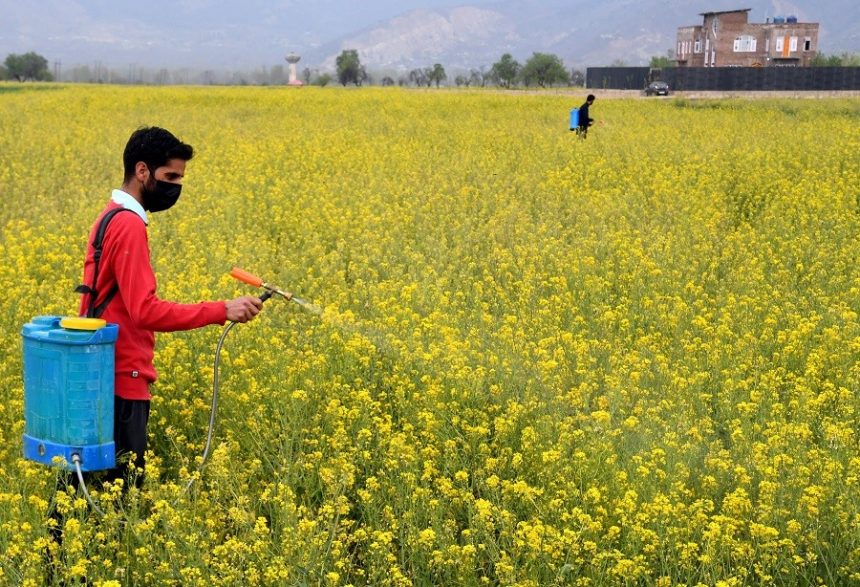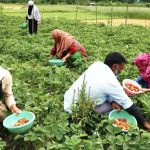The Jammu-Srinagar National Highway is currently offering a stunning sight as vibrant mustard fields line both sides of the road from Qazigund to Pampora. The stretch appears as if one is driving through a different world altogether, with golden-yellow blossoms swaying in the breeze.
Dozens of tourists and commuters can be seen stopping to click photos and record reels amidst these blooming mustard fields. With the rise of social media trends, capturing moments in the mustard season of the Kashmir Valley has become a popular activity.
Sagrikha, a tourist from Mumbai, said she had arrived in Kashmir a couple of days ago and had already visited Srinagar and Gulmarg. On her way to Pahalgam, she was captivated by the mustard fields and couldn’t resist stopping for photographs.
“We were on our way to Pahalgam when we saw the mustard bloom. Every place we’ve visited so far has been incredibly beautiful,” she said. “We have three more days left in Kashmir, but we’ve already enjoyed so much. The experience has been amazing. People here are so kind and welcoming—it feels like being part of a family. Honestly, this is better than any other city I’ve visited, and I would recommend everyone to come and experience it.”
Ankita, another first-time visitor to Kashmir, echoed similar sentiments. “I’ve only been here for three days, but I already feel like coming back again. The culture, the beauty—Kashmir is a place everyone should visit at least once. It has a magical charm that draws you back.”
“What I have seen here is even better than what I imagined from the movies. These mustard fields remind me of the iconic scenes from Bollywood films like Dilwale Dulhania Le Jayenge (DDLJ), and we even tried to recreate them!” she added.
DDLJ is a Bollywood film featuring Shah Rukh Khan and Kajol, released in 1995. One of its iconic scenes, set in a mustard field in Punjab, has since become legendary. Visitors to the mustard blooms in Kashmir often try to recreate that famous moment.
According to officials from the Agriculture Department of Kashmir, around 1.4 lakh hectares of land were brought under mustard cultivation this season. The estimated production is expected to be approximately 1.43 lakh metric tonnes, with an average productivity of 1.02 MT.
Syed Tawseef Ahmad, Area Extension Officer (AEO), Kakapora, said that the total requirement of edible oils in the UT is 14.20 lakh quintals, whereas the UT produces only 3.36 lakh quintals, thus remaining dependent on imports. Hence, this initiative is crucial for the region’s food security and economic growth.
He said that the Department of Agriculture, Kashmir, has also organised the “Sarson Festival” at the district level in the Kashmir Division to disseminate the best post-harvest technologies to be adopted by farmers in oilseed crops.
“The average productivity across Jammu and Kashmir needs to be increased to at least 12 quintals per hectare by the year 2030 to meet the shortfall of 70% in the UT. This gap can be minimized either by increasing the area under oilseeds or by improving the productivity levels of oilseed crops,” he said.
The AEO further added that investing in research and development to improve seed technology can lead to the creation of high-yielding and disease-resistant varieties, which can significantly boost oilseed production. Therefore, it becomes necessary to assess the variability for high-yielding ability and high oil content.
According to the 2024 Economic Survey report, nearly the entire net agricultural land in Kashmir—approximately 1,40,000 hectares, excluding waterlogged areas—was cultivated during the winter under the Yellow Revolution for mustard cultivation.
As soon as tourists enter the Valley through the new Banihal-Qazigund tunnel, they are greeted with sprawling mustard fields on both sides of the highway. This “yellow revolution” of spring in Kashmir is offering a fresh experience to visitors, many of whom rush out of their vehicles to soak in the beauty and create lasting memories amidst the blooming fields.








